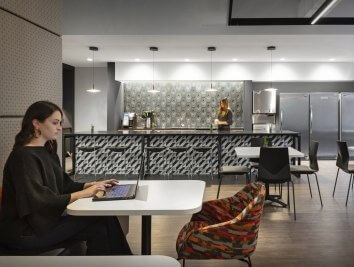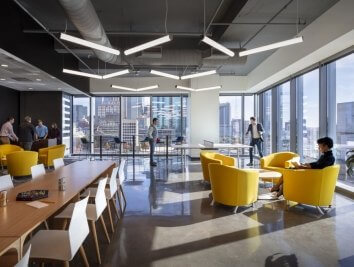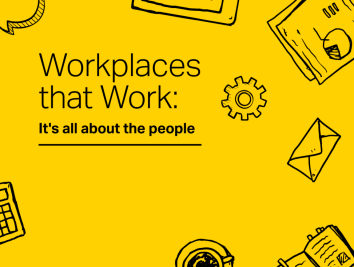Psychology of Trust: How Can We Feel Confident Returning to the Workplace?
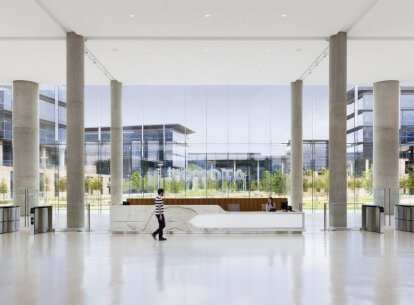
Imagine that after months of social distancing, worrying about the future, and frantically checking the news for COVID-19 updates, restrictions are finally being lifted. It's been announced your office is reopening next week. How do you feel? A little scared, perhaps?
Before employees feel safe returning to the office, they need to have confidence their employers are taking the right measures to protect them from getting sick. So far, businesses are off to a good start. According to the Edelman Trust Barometer, 62 percent of people trust their employer to take responsible action with the coronavirus outbreak. However, this confidence will be tested as employees begin returning to work en masse, viewing their offices through new pandemic-tinted glasses.
So how can we feel confident returning to our places of work? We should first consider the psychology of trust. If we understand the key factors that build a foundation of trust, we can apply this knowledge to the design of our workplaces. Let's start by considering the perceptions of what a clean, healthy environment looks like.
PERCEPTION IS REALITY
For a recent hospital renovation, Corgan was tapped to fix a problem caused by the previous architects' material choices. The showers in the patient rooms were clad in a mottled taupe ceramic tile, mimicking the appearance of limestone. Although the showers were being cleaned regularly, patients kept complaining their showers were dirty. Eventually, it became clear that the tile pattern caused the floors to appear soiled despite actually being clean.
A study of hospital patients in England showed a similar effect. Patients had a hard time separating the physical appearance of the environment from the actual cleanliness. Features such as "nice, well-hung curtains" and "bright airy space," had a significant influence on their perceptions of hygiene within the hospital room. This study also found that worn, poorly maintained areas were associated with inadequate sanitation.
In the post-COVID workplace, the perception of cleanliness will be crucial as well. Avoid finishes that have speckles, splotches, or appear worn looking as these may appear dirty, even when they have been properly sanitized. Also, consider repairing or replacing items that have been damaged. For instance, discolored ceiling tiles or torn upholstery can make space appear less clean than it is.
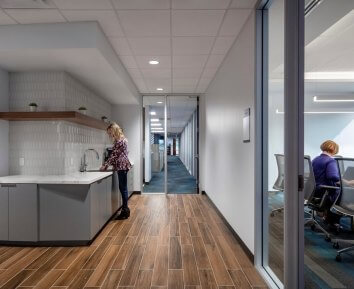
The location of sanitation areas matters too. When it comes to hospitals, studies show that when a sink is within visual distance of a patient, staff are more likely to wash their hands and patients are more likely to rate their experiences as better. Keeping health and wellbeing at the forefront will be essential for workplaces now as well. These types of safety measures should be visible to provide reassurance that responsible precautions are being taken.
With this in mind, consider locating handwashing sinks and hand sanitizer stations in visible areas. While it may be tempting to conceal these items, putting these precautionary measures on display and seeing others washing their hands can increase the perception of cleanliness. Moreover, this visual reminder can encourage good behavior when it comes to handwashing--helping to create a culture of hygiene.
OVERSHARING IS CARING
In reviewing the scientific literature on trust, one fundamental principle emerges again and again: transparency and openness. According to a global study by EY, 59 percent of employees feel that open, transparent communication promotes trust. Bringing staff back to the workplace, a delicate process complicated by navigating the unknown, and meeting the diverse needs of the workforce will require amplified communication and transparency to educate employees about the precautions taken and empower them to confidently engage in the new work culture.
Many of these health and safety measures, such as divider screens between workstations and increased spacing between chairs, will be visible. The unseen safety measures, however, require more explicit communication to ease concerns and anxieties.
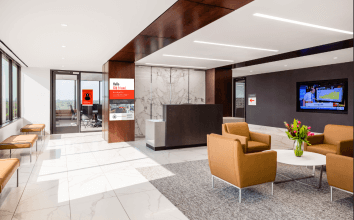
For instance, many buildings are upgrading their HVAC systems to reduce the spread of germs, yet these features are concealed in the ceiling. In these cases, consider adding signage such as "This room is equipped with a clean air disinfection unit located in the ductwork."
Another important measure will be transparency in cleaning procedures as these are ramped up to keep workers safe. Restroom cleaning logs have been around for some time, but displaying these more prominently can reassure employees that facilities are being cleaned frequently. This concept may be extended to desks as well, particularly in offices using a desk-sharing model. For instance, flip cards may be provided at each desk, indicating if the surface has been disinfected (green) or requires cleaning (red).
GRANTING AUTONOMY
Studies show that when people are exposed to an environmental stressor, providing a sense of control can help to reduce stress hormone levels and maintain a healthy immune system. In addition to providing visible sanitation stations, graphics, and signage can be incorporated to educate and empower staff to participate in keeping their workplace healthy. Helpful messages include:
- Please note: Only X number of persons in the room at once
- Wash your hands with soap and water for at least 20 seconds
- Please use the floor markers as guidance for remaining 6 feet apart
- Sanitation stations this way
Keep in mind that the goal of these signs should be to educate and empower staff, not to scare them. Be mindful of language such as "Stop" or "Don't" and images that promote fear. Instead, messaging that comes from a place of positivity, empowerment, and a spirit of education preserves the human-centric design of offices and extends the impact of these measures beyond any single threat or issue. To help, Corgan is developing a social distancing package designed to foster trust. Paige Terrell, director of Branded Environments, describes it this way. "Our approach is a spirit of calm and even welcome and informative in nature."
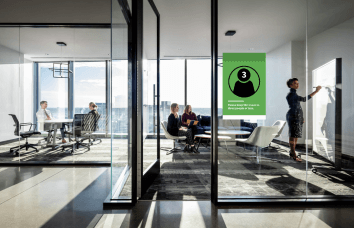
BENEVOLENCE
Another key to building trust is benevolence ─ caring about others' best interests without personal gain. This tendency to trust people who display kindness begins at an early age. A study of young children showed they are more likely to trust information from non-experts who were benevolent (i.e., smiling with a friendly tone) over experts who were mean (i.e., frowning with crossed arms).
Businesses can tap into the concept of benevolence to demonstrate their investment in employees' long-term health and wellbeing, not just their immediate coronavirus concerns. The Fitwel and WELL Building certifications are designed to advance the overall health and wellness of building occupants by focusing on concepts such as enhanced air quality, healthy nourishment, opportunities for physical activity, and access to nature. Even for businesses that do not pursue certification, these same strategies and design solutions can be implemented by degrees to show a lasting commitment to employees' wellbeing.
A TWO-WAY STREET
At the end of the day, trust goes both ways. While businesses can build trust using the methods described above, the responsibility does not fall solely on employers. Employees will also need to be active participants in maintaining a clean, healthy environment. They will need to be diligent in practicing good hygiene while at work and staying home when sick. Each person plays a vital role in protecting the larger group and demonstrating care for one another.
Individual staff will look for cues and expect others to participate in these new best practices—wearing masks, social distancing, and washing hands as appropriate—to feel confident and safe with those around them. Working together, employers and employees can create a culture that not only invests in health and wellbeing but also advances the confidence and trust we need to be at our best.
References
- Bolino, Mark. "Managing Employee Stress and Anxiety During the Coronavirus." Psychology Today, March 17, 2020. https://www.psychologytoday.com/us/blog/the-thoughtful-manager/202003/managing-employee-stress-and-anxiety-during-the-coronavirus.
- “2020 Edelman Trust Barometer.” Edelman.com. Daniel J. Edelman Holdings, Inc., 2020. https://www.edelman.com/trustbarometer.
- Whitehead, Heather, Daryl May, and Helen Agahi. "An Exploratory Study into the Factors That Influence Patients Perceptions of Cleanliness in an Acute NHS Trust Hospital." Journal of Facilities Management 5, no. 4 (February 2007): 275–89. https://doi.org/10.1108/14725960710822268.
- Cloutman-Green, Elaine, Oya Kalaycioglu, Hedieh Wojani, John C. Hartley, Serge Guillas, Deirdre Malone, Vanya Gant, Colin Grey, and Nigel Klein. "The Important Role of Sink Location in Handwashing Compliance and Microbial Sink Contamination." American Journal of Infection Control 42, no. 5 (2014): 554–55.
- "Patients Can 'Be The Difference' in Hand Hygiene Efforts." Becker's Hospital Review. ASC Communications. Accessed May 4, 2020. https://www.beckershospitalreview.com/quality/patients-can-be-the-difference-in-hand-hygiene-efforts.html.
- Butler, John K. "Toward Understanding and Measuring Conditions of Trust: Evolution of a Conditions of Trust Inventory." Journal of Management 17, no. 3 (1991): 643–63. https://doi.org/10.1177/014920639101700307.
- Mcknight, D. Harrison, and Norman L. Chervany. "Trust and Distrust Definitions: One Bite at a Time." Trust in Cyber-Societies Lecture Notes in Computer Science, 2001, 27–54. https://doi.org/10.1007/3-540-45547-7_3.
- "Study: Could Trust Cost You a Generation of Talent? Trust in the Workplace." EY. Accessed May 4, 2020. https://www.ey.com/gl/en/about-us/our-people-and-culture/ey-global-study-trust-in-the-workplace.
- Leotti, Lauren A., Sheena S. Iyengar, and Kevin N. Ochsner. "Born to Choose: The Origins and Value of the Need for Control." Trends in Cognitive Sciences 14, no. 10 (2010): 457–63. https://doi.org/10.1016/j.tics.2010.08.001.
- Landrum, Asheley R., Candice M. Mills, and Angie M. Johnston. "When Do Children Trust the Expert? Benevolence Information Influences Childrens Trust More than Expertise." Developmental Science 16, no. 4 (January 2013): 622–38. https://doi.org/10.1111/desc.12059.
- WELL v2. International WELL Building Institute. Accessed May 4, 2020. https://www.wellcertified.com/certification/v2/.






